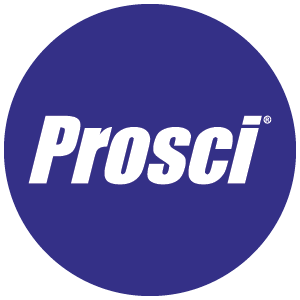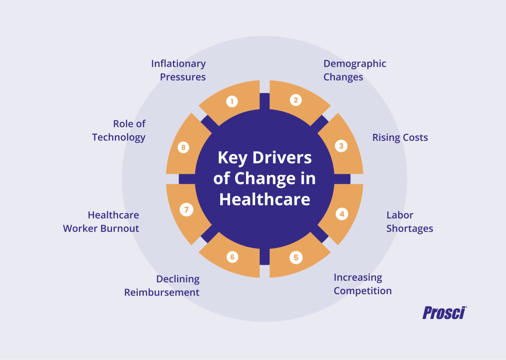What Is Change Management in Healthcare?

6 Mins
Updated: January 9, 2025
Published: February 1, 2024

It's often said that 70% of organizational change initiatives fall short. Yet, Prosci research shows that effective change management can address many change-related problems in healthcare. This begs the question: What is change management in healthcare? Given the rapidly evolving nature of medical technology and the ever-changing regulatory landscape, mastering change management is crucial for any healthcare organization's success.
What is Change Management in Healthcare? Enhancing Care
Imagine transforming your healthcare practice or institution into one that embraces change. Effective change management goes beyond merely adopting new technologies or compliance with regulatory standards; it enhances overall patient care quality and efficiency while improving the employee experience for clinicians and administrative staff. Implementing the right change management strategies enables smoother transitions, better engagement from staff, and efficiencies that contribute to better patient experiences.
This article delves into the nuances of change management in healthcare, highlighting its importance and offering real-world practical strategies for success.
The Basics of Change Management
Change management in healthcare involves striking a balance between technical processes and human dynamics. It focuses on several key concepts:
- Recognizing the need for change: Identifying areas for improvement and equipping healthcare staff to adapt to new technologies and policies effectively.
- Streamlining change adoption: Creating concise plans with defined goals, timelines and resources to ensure healthcare staff effectively adopt new changes in their daily work.
- Effective rollout: Actively implementing the change management plan, adapting as necessary to meet the dynamic healthcare environment.
- Sustaining change: Ensuring that changes become an integral part of the organization, leading to long-term improvements in healthcare operations.
Clear communications, supportive leadership, and engaged stakeholders are the core of change management. Frameworks like the Prosci ADKAR® Model help navigate these waters with a structured, people-first mindset.
What is Change Management in Healthcare?
Facing a range of pressures and budgetary constraints, healthcare systems must prioritize effective change management to maintain quality care and operational efficiency.
Educating yourself on change management in healthcare is key to addressing these critical challenges:
- Inflationary pressures: Healthcare inflation is obvious with the escalating prices of medical equipment, supplies and prescription drugs. Change management enables cost savings by driving higher adoption and usage, faster proficiency and limited rework during changes.
- Labor shortages: The existing labor crisis in healthcare has created a need for higher salaries and better benefits to attract and retain top talent. Change management helps because it puts people first. They feel supported through difficult transitions, which improves morale and retention.
- Demographic changes and chronic diseases: An aging population and growing prevalence of chronic diseases drive up healthcare demand and costs. The increase in service utilization requires more resources, straining healthcare systems. Change management streamlines processes, especially with technology implementations, which can free up resources and capacity for patient care.
- Rising costs and financial sustainability: Budget cutbacks in services and investments in new technology challenge the sustainability of healthcare organizations, impacting their ability to deliver high-quality care. Change management can maximize budgets by reducing costly rework and resistance during change.
- Increasing competition and declining reimbursement: To compete today, healthcare providers must provide quality care with lower reimbursement rates from government and private health insurance. Change management is an effective way for healthcare providers to innovate and find cost-effective solutions that maintain profitability and value-based care.
- Healthcare worker burnout: The increasing demands on healthcare workers exacerbate medical staffing difficulties, especially burnout. Effective change management enables efficiencies that help reduce burnout rates. Managing changes as a portfolio creates additional synergies across projects.
The diverse challenges present in the healthcare sector make change management an invaluable asset. Most significantly, Prosci research shows that projects with effective change management are 7X more likely to succeed. Also, they are more likely to finish on time and within budget (which protects the institution's project investment).
The following graph illustrates the relationship between change management effectiveness and achieving project objectives, showing that 88% of respondents met or exceeded objectives thanks to effective change management implementation.

Strategies and Elements for Effective Change
Understanding change management in healthcare is important, and it requires precision, insight and a collaborative spirit. Here, we outline seven critical strategies and elements that ensure this journey is transformative.
1. Structured frameworks: The Prosci ADKAR Model
The Prosci Methodology—comprised of the Prosci ADKAR Model, the Prosci Change Triangle (PCT) Model, and the 3-Phase Process—is a foundational compass for guiding change in healthcare. With its stages of Awareness, Desire, Knowledge, Ability and Reinforcement, ADKAR is pivotal in leading individuals through change.
2. Stakeholder engagement
Engaging diverse stakeholders is a coordinated effort in a well-run hospital, where each professional member's role, from doctors to administrative staff, contributes to a seamless and effective process. This collaborative approach is key to driving effective adoption and usage.
3. Effective communication
In healthcare change management, clear and consistent communication acts like a unified chorus. It's vital for aligning and engaging medical staff. Imagine a clinic rolling out a new patient care protocol. Synchronized messages and well-timed briefings, coupled with platforms for staff feedback, create a two-way communication stream—much like a choir singing from the same song sheet.
4. Training and support
Providing targeted training and support arms people with the knowledge and skills they need to use the change in their daily work. It prepares healthcare professionals to navigate new systems and processes confidently.
5. Continuous monitoring, measuring and adapting
Continuous monitoring is crucial for aligning change initiatives with clinical and operational goals. It involves regularly assessing the impact of changes on patient care, staff workflows, and overall healthcare delivery.
6. Leadership and communication
Influential healthcare leaders aren’t just decision-makers but also communicators and motivators. They’re role models who inspire people to adopt and implement the change vision and message.

7. Managing Resistance
Addressing resistance involves guiding healthcare staff to embrace new processes or technologies. Focusing on their specific concerns and providing the necessary support ensures that changes are understood and accepted, leading to a more effective and cohesive implementation within patient care environments.
These strategies make change management in healthcare a positive, lasting transformation to benefit all parties.
2 Real-World Applications: Case Studies in Healthcare Change Management
To grasp change management in healthcare, let's examine the following real-world examples. These case studies provide insights into how theoretical concepts are applied successfully in healthcare settings, demonstrating the tangible impact of change management strategies.
Revolutionizing records: The Mayo Clinic's EHR leap
Challenge: Implementing a unified Electronic Health Records system across multiple locations.
Results: Achieved seamless integration, boosting patient care and operational efficiency.
Key strategies: Prioritized comprehensive staff training, maintained ongoing communication, and adopted a gradual rollout to ease adaptability and minimize disruption.
- Structured frameworks (Prosci ADKAR Model) – Utilized for guiding the transition to a unified EHR system.
- Effective communication and stakeholder engagement– Continuous communication and staff training ensured stakeholders were informed and involved.
- Training and support – Thorough training provided to staff for ease of adaptability to the new system.
Holistic care transformation: VHA's CC&ICM initiative
Challenge: Standardizing and integrating care coordination services across all VHA facilities, addressing service fragmentation, and enhancing interprofessional collaboration.
Results: Successfully implemented a more coordinated and integrated care system, reducing service fragmentation and optimizing healthcare resource utilization.
Key strategies: Adopted the ADKAR Model for change management, executed a structured and gradual rollout in three phases and emphasized interprofessional collaboration and communication.
- Structured frameworks – The ADKAR Model was central to managing individual and organizational change, ensuring each step of Awareness, Desire, Knowledge, Ability and Reinforcement was methodically addressed.
- Effective communication and stakeholder engagement – Emphasized ongoing communication and involvement of various healthcare professionals, ensuring cohesive implementation and acceptance of the new model.
- Training and support – Focused on providing extensive training and support to staff, facilitating smooth adaptation to the CC&ICM model and its practices.
These cases showcase successful healthcare change management, leading to improved healthcare delivery, patient satisfaction and operational efficiency.
Navigating Challenges in Healthcare Change Management
Embarking on the journey of change management in healthcare involves skillfully overcoming obstacles for a smooth transition.
Identifying common obstacles: Recognizing potential issues
To begin this, it's crucial to acknowledge the typical hurdles that may arise:
- Resistance to change: This is often rooted in uncertainty about the future or comfort with existing practices. Resistance may stem from new healthcare regulations, technologies or processes in healthcare settings.

- Regulatory and compliance constraints: The complex web of evolving healthcare regulations demands agility and thorough understanding.
- Resource limitations: Scarce resources and tight budgets are common hurdles in executing change, particularly in underfunded departments.
- Complex hierarchies and siloed departments: Bridging the gaps in communication and collaboration across varied healthcare disciplines is essential.
- Technology integration challenges: Seamlessly integrating state-of-the-art technology into existing healthcare systems demands meticulous planning and alignment to avoid disruption and ensure compatibility.
- Staff turnover, change fatigue and burnout: Especially pertinent in healthcare settings, where nurses and other healthcare professionals often work in high-stress conditions, these challenges can disrupt continuity and morale needed for effective change.
Strategies for overcoming challenges: Offering solutions
Healthcare organizations can turn challenges into stepping stones for successful change management by focusing on these critical strategies.
- Engaging stakeholders early: Including medical staff and management from the beginning cultivates their awareness and support of change.
- Transparent and two-way communication: Regular, clear updates build trust and awareness, which is vital in significant healthcare industry transformations such as mergers.
- Resource allocation: Thoughtful distribution of human and financial resources can determine the success or failure of a healthcare change initiative.
- Leadership commitment: Strong, visible leadership is pivotal in providing direction and motivation—particularly during major healthcare organizational changes.
Successfully navigating these challenges hinges on a comprehensive approach that combines understanding, strategic planning and decisive action.
If navigating these complex change management challenges in healthcare seems daunting, remember you don't have to do it alone. Our expert Advisory Services are here to guide you every step of the way.
Embracing Change in Healthcare
Comprehending change management in healthcare is critical to transitioning to efficient, quality-driven care. This article highlights the significance of a structured approach, as demonstrated in case studies like the Mayo Clinic and VHA, emphasizing the Prosci ADKAR Model stakeholder engagement and clear communication.
Key challenges include resistance to change and resource constraints. Still, with early stakeholder engagement, transparent communication, resource allocation, and strong leadership, these can be transformed into opportunities for growth and successful change in healthcare.



